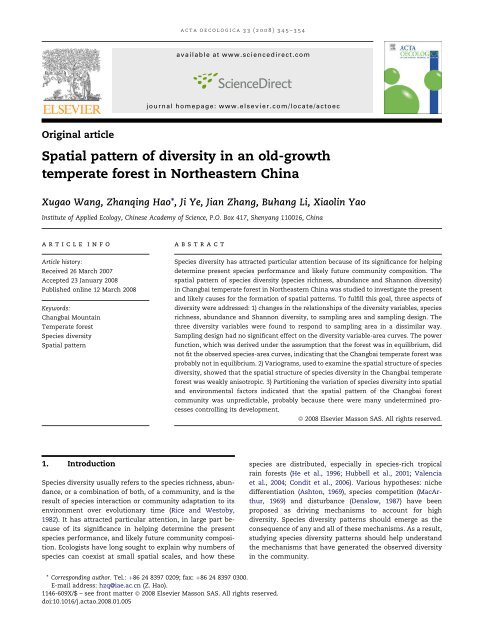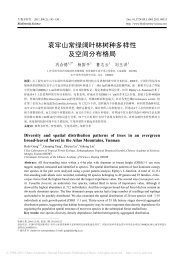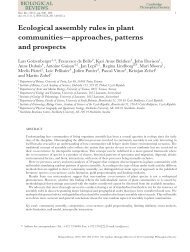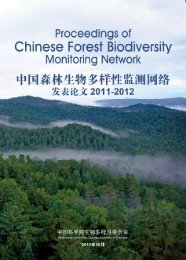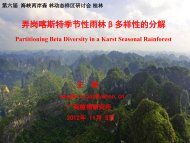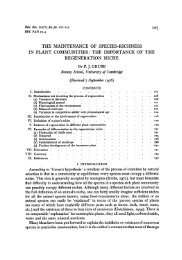Spatial pattern of diversity in an old-growth temperate forest in ...
Spatial pattern of diversity in an old-growth temperate forest in ...
Spatial pattern of diversity in an old-growth temperate forest in ...
Create successful ePaper yourself
Turn your PDF publications into a flip-book with our unique Google optimized e-Paper software.
acta oecologica 33 (2008) 345–354<br />
available at www.sciencedirect.com<br />
journal homepage: www.elsevier.com/locate/actoec<br />
Orig<strong>in</strong>al article<br />
<strong>Spatial</strong> <strong>pattern</strong> <strong>of</strong> <strong>diversity</strong> <strong>in</strong> <strong>an</strong> <strong>old</strong>-<strong>growth</strong><br />
<strong>temperate</strong> <strong>forest</strong> <strong>in</strong> Northeastern Ch<strong>in</strong>a<br />
Xugao W<strong>an</strong>g, Zh<strong>an</strong>q<strong>in</strong>g Hao*, Ji Ye, Ji<strong>an</strong> Zh<strong>an</strong>g, Buh<strong>an</strong>g Li, Xiaol<strong>in</strong> Yao<br />
Institute <strong>of</strong> Applied Ecology, Ch<strong>in</strong>ese Academy <strong>of</strong> Science, P.O. Box 417, Sheny<strong>an</strong>g 110016, Ch<strong>in</strong>a<br />
article <strong>in</strong>fo<br />
Article history:<br />
Received 26 March 2007<br />
Accepted 23 J<strong>an</strong>uary 2008<br />
Published onl<strong>in</strong>e 12 March 2008<br />
Keywords:<br />
Ch<strong>an</strong>gbai Mounta<strong>in</strong><br />
Temperate <strong>forest</strong><br />
Species <strong>diversity</strong><br />
<strong>Spatial</strong> <strong>pattern</strong><br />
abstract<br />
Species <strong>diversity</strong> has attracted particular attention because <strong>of</strong> its signific<strong>an</strong>ce for help<strong>in</strong>g<br />
determ<strong>in</strong>e present species perform<strong>an</strong>ce <strong>an</strong>d likely future community composition. The<br />
spatial <strong>pattern</strong> <strong>of</strong> species <strong>diversity</strong> (species richness, abund<strong>an</strong>ce <strong>an</strong>d Sh<strong>an</strong>non <strong>diversity</strong>)<br />
<strong>in</strong> Ch<strong>an</strong>gbai <strong>temperate</strong> <strong>forest</strong> <strong>in</strong> Northeastern Ch<strong>in</strong>a was studied to <strong>in</strong>vestigate the present<br />
<strong>an</strong>d likely causes for the formation <strong>of</strong> spatial <strong>pattern</strong>s. To fulfill this goal, three aspects <strong>of</strong><br />
<strong>diversity</strong> were addressed: 1) ch<strong>an</strong>ges <strong>in</strong> the relationships <strong>of</strong> the <strong>diversity</strong> variables, species<br />
richness, abund<strong>an</strong>ce <strong>an</strong>d Sh<strong>an</strong>non <strong>diversity</strong>, to sampl<strong>in</strong>g area <strong>an</strong>d sampl<strong>in</strong>g design. The<br />
three <strong>diversity</strong> variables were found to respond to sampl<strong>in</strong>g area <strong>in</strong> a dissimilar way.<br />
Sampl<strong>in</strong>g design had no signific<strong>an</strong>t effect on the <strong>diversity</strong> variable-area curves. The power<br />
function, which was derived under the assumption that the <strong>forest</strong> was <strong>in</strong> equilibrium, did<br />
not fit the observed species-area curves, <strong>in</strong>dicat<strong>in</strong>g that the Ch<strong>an</strong>gbai <strong>temperate</strong> <strong>forest</strong> was<br />
probably not <strong>in</strong> equilibrium. 2) Variograms, used to exam<strong>in</strong>e the spatial structure <strong>of</strong> species<br />
<strong>diversity</strong>, showed that the spatial structure <strong>of</strong> species <strong>diversity</strong> <strong>in</strong> the Ch<strong>an</strong>gbai <strong>temperate</strong><br />
<strong>forest</strong> was weakly <strong>an</strong>isotropic. 3) Partition<strong>in</strong>g the variation <strong>of</strong> species <strong>diversity</strong> <strong>in</strong>to spatial<br />
<strong>an</strong>d environmental factors <strong>in</strong>dicated that the spatial <strong>pattern</strong> <strong>of</strong> the Ch<strong>an</strong>gbai <strong>forest</strong><br />
community was unpredictable, probably because there were m<strong>an</strong>y undeterm<strong>in</strong>ed processes<br />
controll<strong>in</strong>g its development.<br />
ª 2008 Elsevier Masson SAS. All rights reserved.<br />
1. Introduction<br />
Species <strong>diversity</strong> usually refers to the species richness, abund<strong>an</strong>ce,<br />
or a comb<strong>in</strong>ation <strong>of</strong> both, <strong>of</strong> a community, <strong>an</strong>d is the<br />
result <strong>of</strong> species <strong>in</strong>teraction or community adaptation to its<br />
environment over evolutionary time (Rice <strong>an</strong>d Westoby,<br />
1982). It has attracted particular attention, <strong>in</strong> large part because<br />
<strong>of</strong> its signific<strong>an</strong>ce <strong>in</strong> help<strong>in</strong>g determ<strong>in</strong>e the present<br />
species perform<strong>an</strong>ce, <strong>an</strong>d likely future community composition.<br />
Ecologists have long sought to expla<strong>in</strong> why numbers <strong>of</strong><br />
species c<strong>an</strong> coexist at small spatial scales, <strong>an</strong>d how these<br />
species are distributed, especially <strong>in</strong> species-rich tropical<br />
ra<strong>in</strong> <strong>forest</strong>s (He et al., 1996; Hubbell et al., 2001; Valencia<br />
et al., 2004; Condit et al., 2006). Various hypotheses: niche<br />
differentiation (Ashton, 1969), species competition (MacArthur,<br />
1969) <strong>an</strong>d disturb<strong>an</strong>ce (Denslow, 1987) have been<br />
proposed as driv<strong>in</strong>g mech<strong>an</strong>isms to account for high<br />
<strong>diversity</strong>. Species <strong>diversity</strong> <strong>pattern</strong>s should emerge as the<br />
consequence <strong>of</strong> <strong>an</strong>y <strong>an</strong>d all <strong>of</strong> these mech<strong>an</strong>isms. As a result,<br />
study<strong>in</strong>g species <strong>diversity</strong> <strong>pattern</strong>s should help underst<strong>an</strong>d<br />
the mech<strong>an</strong>isms that have generated the observed <strong>diversity</strong><br />
<strong>in</strong> the community.<br />
* Correspond<strong>in</strong>g author. Tel.: þ86 24 8397 0209; fax: þ86 24 8397 0300.<br />
E-mail address: hzq@iae.ac.cn (Z. Hao).<br />
1146-609X/$ – see front matter ª 2008 Elsevier Masson SAS. All rights reserved.<br />
doi:10.1016/j.actao.2008.01.005
346<br />
acta oecologica 33 (2008) 345–354<br />
Recent studies on <strong>diversity</strong> <strong>pattern</strong> have been concentrated<br />
on tropical ra<strong>in</strong> <strong>forest</strong>s where species <strong>diversity</strong> reaches<br />
particularly high levels (He et al., 1996; Hubbell et al.,<br />
1999; de Oliveira <strong>an</strong>d Mori, 1999; Condit et al., 2002, 2006).<br />
For example, a 52 ha plot <strong>in</strong> Borneo <strong>an</strong>d a 25 ha plot <strong>in</strong><br />
Ecuador support 1175 <strong>an</strong>d 1104 tree species, respectively<br />
(Wright, 2002). In contrast, the 4.2 10 6 km 2 <strong>of</strong> <strong>temperate</strong><br />
<strong>forest</strong>s <strong>in</strong> Europe, North America <strong>an</strong>d Asia support only<br />
1166 tree species (Latham <strong>an</strong>d Ricklefs, 1993). In other<br />
words, tree species <strong>diversity</strong> <strong>in</strong> just one small area <strong>in</strong> the<br />
tropics is comparable to the <strong>diversity</strong> <strong>of</strong> the entire North<br />
Temperate Zone. However, because species <strong>diversity</strong> <strong>of</strong><br />
one community <strong>of</strong>ten differs <strong>in</strong> composition, structure <strong>an</strong>d<br />
species attributes from <strong>an</strong>other community, species<br />
<strong>diversity</strong> <strong>in</strong> <strong>temperate</strong> <strong>forest</strong>s has also been a fertile area<br />
<strong>of</strong> research for m<strong>an</strong>y ecologists. For example, Latham <strong>an</strong>d<br />
Ricklefs (1993) suggested that regional effects caused species<br />
<strong>diversity</strong> <strong>of</strong> <strong>temperate</strong> <strong>forest</strong>s to differ between eastern<br />
Asia <strong>an</strong>d North America. Bus<strong>in</strong>g <strong>an</strong>d White (1997) demonstrated<br />
small-scale disturb<strong>an</strong>ces created by tree falls<br />
enh<strong>an</strong>ce pl<strong>an</strong>t species <strong>diversity</strong> <strong>in</strong> <strong>an</strong> Appalachi<strong>an</strong> <strong>old</strong><strong>growth</strong><br />
<strong>temperate</strong> <strong>forest</strong>. Chen <strong>an</strong>d Bradshaw (1999) suggested<br />
the import<strong>an</strong>ce <strong>of</strong> scale <strong>an</strong>d gap-phase regeneration<br />
<strong>in</strong> the spatial <strong>pattern</strong><strong>in</strong>g <strong>of</strong> a <strong>temperate</strong> coniferous <strong>forest</strong>.<br />
Lundholm <strong>an</strong>d Larson (2003) showed the positive correlations<br />
between spatial environmental heterogeneity <strong>an</strong>d<br />
pl<strong>an</strong>t species <strong>diversity</strong> <strong>in</strong> southern Ontario, C<strong>an</strong>ada. Getz<strong>in</strong><br />
et al. (2006) identified tree competition as hav<strong>in</strong>g signific<strong>an</strong>t<br />
<strong>in</strong>fluence on species spatial <strong>pattern</strong> <strong>in</strong> a Douglas-fir <strong>forest</strong> <strong>of</strong><br />
the Pacific Northwest region. W<strong>an</strong>g et al. (2006a,b) suggested<br />
that catastrophic fires decreased species abund<strong>an</strong>ces<br />
dramatically <strong>an</strong>d caused more fragmented spatial <strong>pattern</strong>,<br />
whereas post-fire <strong>an</strong>thropogenic activities (harvest <strong>an</strong>d re<strong>forest</strong>ation)<br />
could differently <strong>in</strong>fluence species abund<strong>an</strong>ce<br />
<strong>an</strong>d distribution <strong>pattern</strong>s <strong>in</strong> Northeastern Ch<strong>in</strong>a. Although<br />
these studies have led ecologists to better underst<strong>an</strong>d the<br />
species <strong>diversity</strong> <strong>of</strong> <strong>temperate</strong> <strong>forest</strong>s, few studies have<br />
focused specifically on how species <strong>diversity</strong> is distributed<br />
spatially over a <strong>temperate</strong> <strong>forest</strong>, <strong>an</strong>d to what extent the<br />
<strong>diversity</strong> <strong>pattern</strong> is regulated by spatial <strong>an</strong>d environmental<br />
factors. S<strong>in</strong>ce most ecological processes are <strong>pattern</strong>-generat<strong>in</strong>g<br />
(Legendre <strong>an</strong>d Fort<strong>in</strong>, 1989; Legendre, 1993), <strong>an</strong>alyz<strong>in</strong>g<br />
the result<strong>in</strong>g spatial <strong>pattern</strong>s may provide import<strong>an</strong>t clues<br />
as to the processes that have generated them (Borcard<br />
<strong>an</strong>d Legendre, 1994).<br />
The objective <strong>of</strong> this study was to study the spatial <strong>pattern</strong><br />
<strong>of</strong> species <strong>diversity</strong> <strong>in</strong> <strong>an</strong> <strong>old</strong>-<strong>growth</strong> <strong>temperate</strong> <strong>forest</strong><br />
<strong>in</strong> Northeastern Ch<strong>in</strong>a based on a large-scale, <strong>in</strong>tensively<br />
sampled plot. Three groups <strong>of</strong> questions were addressed:<br />
(1) How does species <strong>diversity</strong> ch<strong>an</strong>ge with plot size?<br />
What is the relationship between species <strong>diversity</strong> <strong>an</strong>d<br />
area <strong>in</strong> different locations? What mathematical function<br />
best describes the species-area relationships? (2) How is<br />
species <strong>diversity</strong> distributed spatially <strong>in</strong> the <strong>old</strong>-<strong>growth</strong><br />
<strong>temperate</strong> <strong>forest</strong>? Is the distribution <strong>of</strong> <strong>diversity</strong> isotropic<br />
or <strong>an</strong>isotropic? (3) C<strong>an</strong> the <strong>diversity</strong> <strong>pattern</strong> be predicted<br />
by environmental <strong>an</strong>d/or spatial factors? To what extent<br />
do the environmental <strong>an</strong>d the spatial factors (extracted<br />
from the spatial coord<strong>in</strong>ate data) contribute to the observed<br />
spatial <strong>pattern</strong>s?<br />
2. Materials <strong>an</strong>d methods<br />
2.1. Study site<br />
The study site is <strong>in</strong> the Ch<strong>an</strong>gbai Nature Reserve, located<br />
along the border <strong>of</strong> Ch<strong>in</strong>a <strong>an</strong>d North Korea extend<strong>in</strong>g from<br />
127 42 0 to 128 17 0 E<strong>an</strong>d41 43 0 to 42 26 0 N. The reserve, which<br />
was first established <strong>in</strong> 1960 <strong>an</strong>d is one <strong>of</strong> the largest<br />
biosphere reserves <strong>in</strong> Ch<strong>in</strong>a, has been spared from logg<strong>in</strong>g<br />
<strong>an</strong>d other severe hum<strong>an</strong> disturb<strong>an</strong>ces. Furthermore, the<br />
Ch<strong>an</strong>gbai Nature Reserve jo<strong>in</strong>ed the World Biosphere<br />
Reserve Network under the UNESCO M<strong>an</strong> <strong>an</strong>d the Biosphere<br />
Programme <strong>in</strong> 1980. The reserve is about 200,000 ha <strong>in</strong> size<br />
with <strong>an</strong> elevation r<strong>an</strong>g<strong>in</strong>g from 740 m to 2691 m at the<br />
summit <strong>of</strong> Ch<strong>an</strong>gbai Mounta<strong>in</strong>. Ch<strong>an</strong>gbai Mounta<strong>in</strong> is the<br />
highest mounta<strong>in</strong> <strong>in</strong> Northeastern Ch<strong>in</strong>a <strong>an</strong>d is the head<br />
<strong>of</strong> three large rivers (the Songhua, Yalu <strong>an</strong>d Tumen). The<br />
topography <strong>of</strong> the northern slope is relatively moderate<br />
(average slope
acta oecologica 33 (2008) 345–354 347<br />
2.2. Data <strong>an</strong>alyses<br />
Fig. 1 – a. Contour map <strong>of</strong> the 25-ha Ch<strong>an</strong>gbai <strong>temperate</strong><br />
plot. b. The sampl<strong>in</strong>g designs for the study <strong>of</strong> <strong>diversity</strong>area<br />
relations commenced from 10 m 3 10 m quadrats at<br />
five different locations (a–e), <strong>an</strong>d the quadrat size was<br />
doubled until the entire plot was covered.<br />
The total number <strong>of</strong> liv<strong>in</strong>g <strong>in</strong>dividuals <strong>in</strong> the first census<br />
(2004) was 38902, compris<strong>in</strong>g 52 species, 32 genera <strong>an</strong>d 18<br />
families. The ma<strong>in</strong> tree species <strong>in</strong>clude P. koraiensis, T. amurensis,<br />
Q. mongolica, F. m<strong>an</strong>dshurica, Ulmus japonica, <strong>an</strong>d Acer<br />
mono. Unlike tropical ra<strong>in</strong> <strong>forest</strong>s without obvious dom<strong>in</strong><strong>an</strong>t<br />
species, there were 8 species with more th<strong>an</strong> 1000 <strong>in</strong>dividuals,<br />
which accounted for 83.4% <strong>of</strong> all <strong>in</strong>dividuals <strong>in</strong> the<br />
plot. Species-specific tree abund<strong>an</strong>ces <strong>in</strong> the plot r<strong>an</strong>ged<br />
from 1 (3 species: Sorbus pohuash<strong>an</strong>ensis, Act<strong>in</strong>idia kolomakta,<br />
<strong>an</strong>d Rosa dovurica) to 7381 <strong>in</strong>dividuals <strong>of</strong> Corylus m<strong>an</strong>dshurica,<br />
the most abund<strong>an</strong>t species. In addition, by virtue <strong>of</strong> the criterion<br />
that species with 1 <strong>in</strong>dividual per ha was considered<br />
as rare species, there were 18 rare species, account<strong>in</strong>g for<br />
34.6% <strong>of</strong> the total number <strong>of</strong> species <strong>in</strong> the plot. Me<strong>an</strong> st<strong>an</strong>d<br />
density was 1556 liv<strong>in</strong>g trees ha 1 . Me<strong>an</strong> basal area was<br />
43.2 m 2 ha 1 (Hao et al., 2008; W<strong>an</strong>g et al., <strong>in</strong> press).<br />
In this paper, <strong>diversity</strong> refers to richness, abund<strong>an</strong>ce <strong>an</strong>d the<br />
Sh<strong>an</strong>non <strong>diversity</strong> <strong>in</strong>dex. Richness is def<strong>in</strong>ed as the number<br />
<strong>of</strong> species <strong>in</strong> the study area <strong>an</strong>d abund<strong>an</strong>ce as the number<br />
<strong>of</strong> all <strong>in</strong>dividuals. The Sh<strong>an</strong>non <strong>diversity</strong> <strong>in</strong>dex has been<br />
suggested by Margalef (1958) as a synthetic measure <strong>of</strong><br />
community structure.<br />
Different methods were used to <strong>an</strong>swer the questions<br />
stated <strong>in</strong> the Introduction. For question 1, richness, abund<strong>an</strong>ce<br />
<strong>an</strong>d Sh<strong>an</strong>non <strong>diversity</strong> were measured <strong>in</strong> square plots<br />
that r<strong>an</strong>ged from 10 m 10 m to the complete 25-ha plot for<br />
five start<strong>in</strong>g locations shown <strong>in</strong> Fig. 1b (a, b, c, d <strong>an</strong>d e). The<br />
expected species-area curve (null model) was also computed<br />
under the assumption that all species <strong>in</strong> the study area were<br />
r<strong>an</strong>domly distributed (Colem<strong>an</strong> et al., 1982; He <strong>an</strong>d Legendre,<br />
2002). The species-area relations were fitted by three models:<br />
the power model, the exponential model <strong>an</strong>d the logistic<br />
model. The statistical criterion for the fit <strong>of</strong> a species-area<br />
curve is the sum <strong>of</strong> squares <strong>of</strong> the residuals. The simplest<br />
way to test whether models are signific<strong>an</strong>tly different is to<br />
check the 95% confidence <strong>in</strong>tervals <strong>of</strong> the model parameters<br />
(Sokal <strong>an</strong>d Rohlf, 1981). If there is no overlap <strong>in</strong> the confidence<br />
<strong>in</strong>tervals for correspond<strong>in</strong>g parameters, then we conclude<br />
they are signific<strong>an</strong>tly different. All the statistical tests <strong>of</strong><br />
signific<strong>an</strong>ce <strong>an</strong>d confidence <strong>in</strong>tervals <strong>in</strong> this paper were<br />
computed at the a ¼ 0.05 level.<br />
For question 2, variogram <strong>an</strong>alysis was used to detect the<br />
spatial distribution <strong>of</strong> species <strong>diversity</strong>, because the semivari<strong>an</strong>ce<br />
is evaluated from the differences between pairs <strong>of</strong><br />
observations over predeterm<strong>in</strong>ed dist<strong>an</strong>ce classes <strong>an</strong>d emphasizes<br />
heterogeneity (Legendre <strong>an</strong>d Legendre, 1998). A typical<br />
variogram c<strong>an</strong> be described us<strong>in</strong>g three basic parameters:<br />
(1) the r<strong>an</strong>ge is the dist<strong>an</strong>ce at which the semi-vari<strong>an</strong>ce ceases<br />
to <strong>in</strong>crease (i.e. the spatial <strong>in</strong>fluence disappears); (2) the sill is<br />
the semi-vari<strong>an</strong>ce value that the variogram reaches at the<br />
r<strong>an</strong>ge; <strong>in</strong> theoretical variograms, the sill equals the overall<br />
vari<strong>an</strong>ce <strong>of</strong> a variable; <strong>an</strong>d (3) the nugget effect is the ord<strong>in</strong>ate<br />
value <strong>of</strong> the variogram at dist<strong>an</strong>ce zero; it need not be equal to<br />
zero. It corresponds to the local variation occurr<strong>in</strong>g at scales<br />
f<strong>in</strong>er th<strong>an</strong> the sampl<strong>in</strong>g <strong>in</strong>terval, such as sampl<strong>in</strong>g error,<br />
f<strong>in</strong>e-scale spatial variability, <strong>an</strong>d measurement error. The<br />
ratio <strong>of</strong> the nugget effect to the sill is referred to as the relative<br />
nugget effect; it c<strong>an</strong> be used to evaluate sampl<strong>in</strong>g error <strong>an</strong>d<br />
short-scale spatial effect. To determ<strong>in</strong>e the strength <strong>of</strong> <strong>an</strong>isotropy,<br />
variograms <strong>of</strong> richness, abund<strong>an</strong>ce <strong>an</strong>d Sh<strong>an</strong>non<br />
<strong>diversity</strong> were computed <strong>in</strong> four geographic directions:<br />
0 (south-north: SN), 90 (west-east: WE), 45 (SW to NE) <strong>an</strong>d<br />
135 (SE to NW).<br />
For question 3, the spatial <strong>pattern</strong>s <strong>of</strong> <strong>diversity</strong> <strong>in</strong> Ch<strong>an</strong>gbai<br />
<strong>temperate</strong> <strong>forest</strong> were explored through environmental <strong>an</strong>d<br />
spatial factors, follow<strong>in</strong>g a polynomial trend-surface <strong>an</strong>alysis<br />
(Borcard et al., 1992). The ‘spatial’ data matrix was constructed<br />
from all quadrat locations (x <strong>an</strong>d y coord<strong>in</strong>ates) <strong>in</strong> the Ch<strong>an</strong>gbai<br />
plot, by <strong>in</strong>clud<strong>in</strong>g all terms <strong>of</strong> a cubic trend-surface<br />
polynomial equation (the x <strong>an</strong>d y geographic coord<strong>in</strong>ates<br />
were centred on their respective me<strong>an</strong>s before comput<strong>in</strong>g<br />
the other terms <strong>of</strong> the geographic polynomial). A stepwise selection<br />
procedure was used to discard the terms <strong>of</strong> the trend
348<br />
acta oecologica 33 (2008) 345–354<br />
surface equation whose contribution to each <strong>of</strong> the three<br />
vectors <strong>of</strong> species <strong>diversity</strong> data was not signific<strong>an</strong>t (P < 0.01).<br />
The follow<strong>in</strong>g terms were reta<strong>in</strong>ed for the three trend surface<br />
equations <strong>of</strong> species richness (S ), abund<strong>an</strong>ce (A), <strong>an</strong>d<br />
Sh<strong>an</strong>non <strong>diversity</strong> (D), respectively:<br />
S ¼ b 1 x þ b 2 y þ b 3 x 2 þ b 4 xy 2<br />
A ¼ b 1 y þ b 2 xy 2 þ b 3 y 3<br />
D ¼ b 1 x þ b 2 x 2 þ b 3 x 2 y<br />
Topographical data (elevation <strong>an</strong>d slope) were the only<br />
synthetic environmental variables available; they are related<br />
to <strong>an</strong>d <strong>in</strong>dicators <strong>of</strong> several abiotic factors, such as dra<strong>in</strong>age<br />
condition, nutrient flow, etc. All variables were measured at<br />
the scale <strong>of</strong> 10 m 10 m quadrats <strong>in</strong> the 25-ha plot. The<br />
same elim<strong>in</strong>ation procedure as for question 1 above was<br />
applied to the environmental data <strong>an</strong>d their comb<strong>in</strong>ation<br />
(relative elevation z 1 <strong>an</strong>d slope z 2 ), resulted <strong>in</strong> the follow<strong>in</strong>g<br />
equations for species richness (S ), abund<strong>an</strong>ce (A), <strong>an</strong>d Sh<strong>an</strong>non<br />
<strong>diversity</strong> (D), respectively:<br />
S ¼ c 1 z 1 þ c 2 z 2 2 þ c 3z 1 z 2<br />
A ¼ c 1 z 1 þ c 2 z 3 1<br />
D ¼ c 1 z 1 þ c 2 z 2<br />
Partial regression <strong>an</strong>alysis was applied to measure the<br />
amount <strong>of</strong> variation <strong>in</strong> each <strong>of</strong> the three vectors <strong>of</strong> <strong>diversity</strong><br />
data <strong>in</strong> turn that could be expla<strong>in</strong>ed by the environmental factor,<br />
spatial variable or their <strong>in</strong>teractions. The total variation <strong>of</strong><br />
a variable is decomposed <strong>in</strong>to four fractions (Borcard et al.,<br />
1992; He et al., 1996), as described below:<br />
(a) Pure spatial contribution. This is the pure spatial effect<br />
that c<strong>an</strong>not be described by the environmental variables,<br />
that is, is <strong>in</strong>dependent <strong>of</strong> <strong>an</strong>y environmental<br />
variables.<br />
(b) <strong>Spatial</strong> þ environmental contribution. This is the proportion<br />
<strong>of</strong> variation expla<strong>in</strong>ed by the environmental <strong>an</strong>d<br />
the spatial variables together. Two types <strong>of</strong> situation<br />
may be responsible for this fraction <strong>of</strong> variation: firstly,<br />
<strong>diversity</strong> may vary spatially as a function <strong>of</strong> the<br />
environmental factors <strong>in</strong> the model or, secondly, there<br />
may exist other processes, unidentified <strong>in</strong> the regression<br />
model under study, which control both the<br />
species <strong>diversity</strong> <strong>an</strong>d the environmental factors <strong>in</strong> the<br />
model.<br />
(c) Pure environmental contribution. This is the proportion <strong>of</strong> the<br />
<strong>diversity</strong> variation <strong>in</strong>dependent <strong>of</strong> <strong>an</strong>y spatial structure.<br />
(d) Undeterm<strong>in</strong>ed contribution. This fraction, which measures<br />
the unexpla<strong>in</strong>ed fraction <strong>of</strong> variation, does not possess<br />
large-scale spatial structure which would have come out<br />
<strong>in</strong> fractions (b) or (c). It may be the consequence <strong>of</strong> stochastic<br />
fluctuations or sampl<strong>in</strong>g error, or it may reflect some<br />
spatially structured variation which exists at a scale<br />
smaller th<strong>an</strong> the sampl<strong>in</strong>g scale.<br />
3. Results<br />
3.1. Species <strong>diversity</strong><br />
In the Ch<strong>an</strong>gbai plot, the species-area relationship described<br />
the tendency for species richness to <strong>in</strong>crease with sampl<strong>in</strong>g<br />
area; a relationship whose slope decl<strong>in</strong>es (but rema<strong>in</strong>s<br />
positive) as sampl<strong>in</strong>g area <strong>in</strong>creased. When the sampl<strong>in</strong>g<br />
area <strong>in</strong>creased to 5 ha, there were about 42 species <strong>in</strong> all<br />
sampl<strong>in</strong>g designs, approximately 80% <strong>of</strong> the total number <strong>of</strong><br />
species <strong>in</strong> the Ch<strong>an</strong>gbai plot, then the curve slowed becom<strong>in</strong>g<br />
asymptotic (Fig. 2). Among the three models, the logistic<br />
model best described the species-area curves (Fig. 3), with<br />
the lowest sums <strong>of</strong> residuals (Table 1). Furthermore, the<br />
different sampl<strong>in</strong>g designs (Fig. 1b) did not signific<strong>an</strong>tly affect<br />
the parameters <strong>of</strong> the model. For example, the limits <strong>of</strong> the<br />
95% confidence <strong>in</strong>tervals for parameter a <strong>in</strong> the logistic model<br />
for sample designs a <strong>an</strong>d b are (60.95, 71.51) <strong>an</strong>d (50.72, 63.68),<br />
respectively (Table 1), which shows no signific<strong>an</strong>t difference.<br />
However, the expected species-area curve was signific<strong>an</strong>tly<br />
different from the observed species-area curves (Fig. 2),<br />
show<strong>in</strong>g that species <strong>in</strong> the Ch<strong>an</strong>gbai <strong>temperate</strong> <strong>forest</strong> plot<br />
are not r<strong>an</strong>domly distributed.<br />
The relations between abund<strong>an</strong>ce <strong>an</strong>d sampl<strong>in</strong>g area are<br />
extremely well fitted by l<strong>in</strong>ear models (Fig. 4). The confidence<br />
<strong>in</strong>tervals <strong>of</strong> the parameters <strong>of</strong> the l<strong>in</strong>ear models <strong>in</strong>dicate that<br />
these models are not signific<strong>an</strong>tly different among sampl<strong>in</strong>g<br />
designs. For example, the limits <strong>of</strong> the confidence <strong>in</strong>tervals<br />
<strong>of</strong> slope for designs a <strong>an</strong>d b are (2360.23, 2391.19) <strong>an</strong>d<br />
(2377.22, 2402.12), respectively. The predicted values <strong>of</strong><br />
abund<strong>an</strong>ce would not vary signific<strong>an</strong>tly for different sampl<strong>in</strong>g<br />
designs. The density (<strong>in</strong>dividuals/unit area) -area curves<br />
(Fig. 5) show that the density <strong>in</strong> different sampl<strong>in</strong>g designs<br />
varies greatly, especially with<strong>in</strong> sampl<strong>in</strong>g areas less th<strong>an</strong><br />
5–10 ha. This <strong>in</strong>dicates that with smaller sample sizes, the<br />
vari<strong>an</strong>ce <strong>of</strong> the estimates would be very large.<br />
Species richness<br />
60<br />
50<br />
40<br />
30<br />
20<br />
10<br />
0<br />
0 5 10 15 20 25<br />
Area (ha)<br />
Fig. 2 – Species richness-area curves. a–e <strong>in</strong>dicate different<br />
sampl<strong>in</strong>g designs <strong>of</strong> Fig. 1b. f is the expected richness-area<br />
curve under the assumption that all species are r<strong>an</strong>domly<br />
distributed over the study area.<br />
a<br />
b<br />
c<br />
d<br />
e<br />
f
acta oecologica 33 (2008) 345–354 349<br />
60<br />
50<br />
parameters for the same model show that for different sampl<strong>in</strong>g<br />
designs, the model parameters may not be signific<strong>an</strong>tly<br />
different.<br />
Species richness<br />
40<br />
30<br />
20<br />
10<br />
True<br />
Logistic model<br />
Exponential model<br />
Power model<br />
0<br />
0 5 10 15 20 25<br />
Area (ha)<br />
Fig. 3 – Logistic, Exponential <strong>an</strong>d Power models fitted to the<br />
species richness-area relations for sampl<strong>in</strong>g design a.<br />
The relationship between Sh<strong>an</strong>non <strong>diversity</strong> <strong>an</strong>d area also<br />
shows that Sh<strong>an</strong>non <strong>diversity</strong> varies greatly with<strong>in</strong> small<br />
sample areas <strong>in</strong> different sampl<strong>in</strong>g designs <strong>in</strong> the Ch<strong>an</strong>gbai<br />
<strong>temperate</strong> <strong>forest</strong> plot (Fig. 6). The Sh<strong>an</strong>non <strong>diversity</strong>-area<br />
curves are best fitted neither by the power nor by the exponential<br />
model, but by a parabolic model (Fig. 7 <strong>an</strong>d Table 2).<br />
In addition, the confidence <strong>in</strong>tervals <strong>of</strong> correspond<strong>in</strong>g<br />
3.2. <strong>Spatial</strong> structure <strong>of</strong> species <strong>diversity</strong><br />
The variograms <strong>of</strong> richness (Fig. 8, 1a, 2a) show some evidence<br />
<strong>of</strong> <strong>an</strong>isotropy <strong>in</strong> that the semi-vari<strong>an</strong>ces <strong>in</strong>crease relatively<br />
quickly with <strong>in</strong>creased dist<strong>an</strong>ces for 90 <strong>an</strong>d 135 , whereas<br />
there are only slight <strong>in</strong>creases for the other two directions.<br />
However, although the semi-vari<strong>an</strong>ces for species richness<br />
are not equal <strong>in</strong> the four directions, the difference is not obvious,<br />
probably because <strong>of</strong> relatively low species <strong>diversity</strong> <strong>in</strong><br />
Ch<strong>an</strong>gbai <strong>temperate</strong> <strong>forest</strong>. In addition, the relative nugget<br />
effect for the four directions is similar, about 54% (Fig. 8, 1a<br />
<strong>an</strong>d 2a). The spatial structure <strong>of</strong> abund<strong>an</strong>ce shows that the<br />
rapid <strong>in</strong>crease <strong>in</strong> semi-vari<strong>an</strong>ces <strong>in</strong> the small dist<strong>an</strong>ce classes<br />
<strong>in</strong>dicates that r<strong>an</strong>dom variation characterizes the distributions<br />
<strong>of</strong> abund<strong>an</strong>ce (Fig. 8, 1b <strong>an</strong>d 2b). In addition, the nugget<br />
effects for the four directions are high, more th<strong>an</strong> 85%,<br />
although the nugget effects <strong>of</strong> the 0 <strong>an</strong>d 90 variograms<br />
seem lower th<strong>an</strong> for the 45 <strong>an</strong>d 135 directions. In addition,<br />
<strong>in</strong> the 135 direction, the semi-vari<strong>an</strong>ce <strong>of</strong> abund<strong>an</strong>ce<br />
decreases greatly after the dist<strong>an</strong>ce exceeds about 200 m,<br />
which is obviously different to the other three directions.<br />
The spatial structure <strong>of</strong> Sh<strong>an</strong>non <strong>diversity</strong> shows pure nugget<br />
effect <strong>in</strong> the 0 <strong>an</strong>d 45 direction, which exhibits no spatial<br />
auto-correlation at the study scale. However, <strong>in</strong> the other<br />
directions, the semi-vari<strong>an</strong>ces <strong>in</strong>crease with dist<strong>an</strong>ce,<br />
Table 1 – Comparisons <strong>of</strong> three species (S)-area (A) models: logistic, exponential <strong>an</strong>d power. a–e <strong>in</strong>dicate the different<br />
sampl<strong>in</strong>g designs <strong>of</strong> Fig. 1. f is the expected species-area curve, <strong>an</strong>d g is the large-tree group. ‘Residual’ is the sum <strong>of</strong><br />
squared residuals after fitt<strong>in</strong>g the given model, <strong>an</strong>d ‘conf. <strong>in</strong>terval’ is the half-width <strong>of</strong> the 95% confidence <strong>in</strong>tervals <strong>of</strong> the<br />
parameter values. The logistic model is the best one to fit species-area curves, whereas the power model is the worst<br />
Models sampl<strong>in</strong>g Logistic model Exponential model Power model<br />
S ¼ a=b þ expð glnðAÞÞ S ¼ a þ blnðAÞ S ¼ aA b<br />
Parameters conf.<br />
<strong>in</strong>terval<br />
Residual<br />
Parameters conf.<br />
<strong>in</strong>terval<br />
Residual<br />
Parameters conf.<br />
<strong>in</strong>terval<br />
Residual<br />
a a ¼ 66.23 5.28 122.87 a ¼ 32.54 0.7 192.68 a ¼ 31.17 1.19 395.3<br />
b ¼ 1.07 0.14 b ¼ 6.28 0.32 b ¼ 0.18 0.02<br />
g ¼ 0.48 0.05<br />
b a ¼ 57.2 6.48 93.49 a ¼ 32.33 0.49 95.42 a ¼ 30.84 0.91 231.73<br />
b ¼ 0.81 0.18 b ¼ 6.17 0.22 b ¼ 0.17 0.01<br />
g ¼ 0.39 0.06<br />
c a ¼ 58.81 7.31 118.26 a ¼ 31.24 0. 51 104.21 a ¼ 28.82 0.99 269.6<br />
b ¼ 0.91 0.21 b ¼ 6.08 0.24 b ¼ 0.18 0.01<br />
g ¼ 0.42 0.07<br />
d a ¼ 44.29 6.13 127.72 a ¼ 29.43 0. 61 143.35 a ¼ 27.67 0.84 193.06<br />
b ¼ 0.57 1.96 b ¼ 6.12 0.27 b ¼ 0.19 0.01<br />
g ¼ 0.36 0.07<br />
e a ¼ 53.46 4.94 99.99 a ¼ 30.22 0. 67 176.58 a ¼ 28.47 1.09 322.8<br />
b ¼ 0.84 0.14 b ¼ 6.7 0.3 b ¼ 0.2 0.02<br />
g ¼ 0.29 0.06<br />
f a ¼ 103.9 1.35 1.07 a ¼ 35.94 0.45 80.3 a ¼ 35.13 1.09 345.18<br />
b ¼ 1.81 0.03 b ¼ 5.59 0.2 b ¼ 0.14 0.01<br />
g ¼ 0.5 0.01<br />
g a ¼ 31.38 2.8 31.03 a ¼ 15.76 0.35 47.8 a ¼ 15 0.76 157.18<br />
b ¼ 1.03 0.14 b ¼ 3.7 0.16 b ¼ 0.2 0.02<br />
g ¼ 0.6 0.07
350<br />
acta oecologica 33 (2008) 345–354<br />
40000<br />
3<br />
Species abund<strong>an</strong>ce (N)<br />
30000<br />
20000<br />
a<br />
b<br />
10000<br />
c<br />
d<br />
e<br />
0<br />
0 5 10 15 20 25<br />
Area (ha)<br />
Sh<strong>an</strong>non <strong>diversity</strong> <strong>in</strong>dex<br />
2.5<br />
2<br />
1.5<br />
1<br />
0.5<br />
0 5 10 15 20 25<br />
Area (ha)<br />
a<br />
b<br />
c<br />
d<br />
e<br />
Fig. 4 – Abund<strong>an</strong>ce-area curves for the different sampl<strong>in</strong>g<br />
designs <strong>of</strong> Fig. 1b.<br />
Fig. 6 – Sh<strong>an</strong>non <strong>diversity</strong>-area curves. a–e <strong>in</strong>dicate<br />
different sampl<strong>in</strong>g designs <strong>in</strong> Fig. 1b.<br />
especially <strong>in</strong> the 135 direction (Fig. 8, 1c <strong>an</strong>d 2c). In the study<br />
area <strong>of</strong> the Ch<strong>an</strong>gbai <strong>temperate</strong> <strong>forest</strong>, the spatial structure <strong>of</strong><br />
Sh<strong>an</strong>non <strong>diversity</strong> is closer to richness th<strong>an</strong> abund<strong>an</strong>ce at the<br />
scales observed.<br />
3.3. Species spatial <strong>pattern</strong>s<br />
3.3.1. Richness<br />
The total vari<strong>an</strong>ce <strong>of</strong> richness is 3.07 (Fig. 8, 1a <strong>an</strong>d 2a) <strong>an</strong>d the<br />
coefficient <strong>of</strong> variation (CV) is 28.5%. The expla<strong>in</strong>ed portion <strong>of</strong><br />
variation (a þ b þ c) is only 7.7% <strong>of</strong> the total variation <strong>in</strong> the<br />
richness data. However, the undeterm<strong>in</strong>ed proportion (d) is<br />
very high (Fig. 9), <strong>in</strong>dicat<strong>in</strong>g that the contributions a, b <strong>an</strong>d c<br />
to the spatial <strong>pattern</strong>s <strong>of</strong> <strong>diversity</strong> are very low. The spatially<br />
structured environmental contribution (b) is higher th<strong>an</strong> for<br />
the abund<strong>an</strong>ce data.<br />
3.3.2. Abund<strong>an</strong>ce<br />
The total vari<strong>an</strong>ce <strong>of</strong> the abund<strong>an</strong>ce data is 110.74 (Fig. 8, 1b,<br />
2b) <strong>an</strong>d the coefficient <strong>of</strong> variation (CV) is 44.5%. The results<br />
show that the expla<strong>in</strong>ed portion (a þ b þ c) accounts for 2.7%<br />
<strong>of</strong> the total variation <strong>of</strong> the abund<strong>an</strong>ce data (Fig. 9). The topographic<br />
<strong>an</strong>d spatial contribution (a, b, <strong>an</strong>d c) is, similarly,<br />
very low, <strong>in</strong>dicat<strong>in</strong>g that the relationship <strong>of</strong> the abund<strong>an</strong>ce<br />
data to topographic <strong>an</strong>d spatial factors is weak. The<br />
undeterm<strong>in</strong>ed proportion (d) for abund<strong>an</strong>ce is also very<br />
high (97.3%).<br />
4000<br />
2.5<br />
Density (N/ha)<br />
3000<br />
2000<br />
1000<br />
0<br />
0 5 10 15 20 25<br />
Area (ha)<br />
Fig. 5 – Density-area curves. a–e <strong>in</strong>dicates different<br />
sampl<strong>in</strong>g designs <strong>in</strong> Fig. 1b.<br />
a<br />
b<br />
c<br />
d<br />
e<br />
Sh<strong>an</strong>non <strong>diversity</strong> <strong>in</strong>dex<br />
2<br />
1.5<br />
1<br />
True<br />
Parabolic model<br />
Exponential model<br />
Power model<br />
0.5<br />
-5 -4 -3 -2 -1 0 1 2 3 4<br />
ln(area)<br />
Fig. 7 – Parabolic model, exponential model <strong>an</strong>d power<br />
models fitted to the Sh<strong>an</strong>non <strong>diversity</strong>-ln(area) relation for<br />
sampl<strong>in</strong>g design a.
acta oecologica 33 (2008) 345–354 351<br />
Table 2 – Comparison <strong>of</strong> three Sh<strong>an</strong>non <strong>diversity</strong> (D)-area (A) models: parabolic, exponential <strong>an</strong>d power. a to e <strong>in</strong>dicate the<br />
different sampl<strong>in</strong>g designs <strong>of</strong> Fig. 1. ‘Residual’ is the sum <strong>of</strong> squared residuals after fitt<strong>in</strong>g the given model, <strong>an</strong>d ‘conf.<br />
<strong>in</strong>terval’ is the half-width <strong>of</strong> the 95% confidence <strong>in</strong>tervals <strong>of</strong> the parameter values. The parabolic model is the best one to fit<br />
Sh<strong>an</strong>non <strong>diversity</strong>-area curves, whereas the power model is the worst<br />
Models sampl<strong>in</strong>g Parabolic model Exponential model Power model<br />
D ¼ a þ blnðAÞþglnðAÞ 2 D ¼ a þ blnðAÞ D ¼ aA b<br />
Parameters conf.<br />
<strong>in</strong>terval<br />
Residual<br />
Parameters conf.<br />
<strong>in</strong>terval<br />
Residual<br />
Parameters conf.<br />
<strong>in</strong>terval<br />
Residual<br />
a a ¼ 2.17 0.04 0.34 a ¼ 2.08 0.04 0.72 a ¼ 2.07 0.05 0.79<br />
b ¼ 0.1 0.014 b ¼ 0.09 0.02 b ¼ 0.04 0.01<br />
g ¼ 0.02 0.006<br />
b a ¼ 2.56 0.04 0.26 a ¼ 2.35 0.07 1.96 a ¼ 2.35 0.07 1.97<br />
b ¼ 0.04 0.012 b ¼ 0.03 0.03 b ¼ 0.01 0.014<br />
g ¼ 0.05 0.006<br />
c a ¼ 2.01 0.047 0.46 a ¼ 1.97 0. 04 0.50 a ¼ 1.97 0.04 0.53<br />
b ¼ 0.09 0.016 b ¼ 0.08 0.01 b ¼ 0.04 0.01<br />
g ¼ 0.01 0.007<br />
d a ¼ 2.05 0.043 0.40 a ¼ 1.92 0. 05 1.06 a ¼ 1.92 0.06 1.22<br />
b ¼ 0.13 0.015 b ¼ 0.12 0.02 b ¼ 0.056 0.014<br />
g ¼ 0.03 0.006<br />
e a ¼ 2.01 0.018 0.07 a ¼ 1.98 0. 02 0.10 a ¼ 1.98 0.02 0.13<br />
b ¼ 0.1 0.006 b ¼ 0.1 0.01 b ¼ 0.047 0.004<br />
g ¼ 0.01 0.003<br />
3.3.3. Diversity<br />
The total vari<strong>an</strong>ce for Sh<strong>an</strong>non <strong>diversity</strong> is 0.12 (Fig. 8, 1c, 2c);<br />
its coefficient <strong>of</strong> variation (CV) is only 25.6%. However, the<br />
results show that the expla<strong>in</strong>ed portion (a þ b þ c) accounts<br />
for only 6.7% <strong>of</strong> the total variation <strong>of</strong> the Sh<strong>an</strong>non <strong>diversity</strong><br />
data (Fig. 9) <strong>of</strong> which topographic <strong>an</strong>d spatial factors make<br />
low contributions. The spatially structured environmental<br />
contribution (b) is higher th<strong>an</strong> for the abund<strong>an</strong>ce data but<br />
similar to the richness data. As before, the undeterm<strong>in</strong>ed<br />
proportion (d) is high.<br />
4. Discussion <strong>an</strong>d conclusion<br />
4.1. Species <strong>diversity</strong><br />
The three <strong>diversity</strong> variables ch<strong>an</strong>ge differently with <strong>in</strong>creas<strong>in</strong>g<br />
sampl<strong>in</strong>g area, because they represent two categories <strong>of</strong><br />
variables that have very different spatial properties. Abund<strong>an</strong>ce<br />
is additive when aggregated across sampl<strong>in</strong>g areas,<br />
whereas richness <strong>an</strong>d Sh<strong>an</strong>non <strong>diversity</strong> are non-additive<br />
(He <strong>an</strong>d Legendre, 1996; Legendre <strong>an</strong>d Legendre, 1998; He<br />
et al., 2002). For example, assume n 1 <strong>an</strong>d n 2 are the abund<strong>an</strong>ces<br />
<strong>of</strong> species <strong>in</strong> two adjacent subplots, <strong>an</strong>d s 1 <strong>an</strong>d s 2 are<br />
their correspond<strong>in</strong>g species richness values. The total abund<strong>an</strong>ce<br />
<strong>in</strong> the two comb<strong>in</strong>ed subplots n ¼ n 1 þ n 2 , whereas the<br />
total number <strong>of</strong> species s s 1 þ s 2 (the equal sign h<strong>old</strong>s only<br />
when the two subplots have totally different species composition).<br />
Sh<strong>an</strong>non <strong>diversity</strong> is a comb<strong>in</strong>ation <strong>of</strong> species richness<br />
<strong>an</strong>d abund<strong>an</strong>ce, which is also non-additive. As a result, the<br />
Sh<strong>an</strong>non <strong>diversity</strong> <strong>in</strong> the comb<strong>in</strong>ed plot also does not equal<br />
the sum <strong>of</strong> that <strong>in</strong> the two subplots.<br />
The species-area relationship is well fitted by the logistical<br />
model but not the power model. The power model assumes<br />
a dynamic equilibrium (Preston, 1960; MacArthur <strong>an</strong>d Wilson,<br />
1967). Our results suggest that the <strong>temperate</strong> <strong>forest</strong> under<br />
study would not be <strong>in</strong> a state <strong>of</strong> equilibrium. If the <strong>forest</strong><br />
were <strong>in</strong> equilibrium, species abund<strong>an</strong>ce would be estimated<br />
<strong>in</strong> <strong>an</strong> unbiased way by <strong>an</strong>y sample size as trees would be r<strong>an</strong>domly<br />
distributed throughout the plot. However, <strong>in</strong> the<br />
Ch<strong>an</strong>gbai plot, the density <strong>in</strong> the different designs varied<br />
greatly, especially with<strong>in</strong> small sampl<strong>in</strong>g areas, <strong>in</strong>dicat<strong>in</strong>g<br />
that the trees were not r<strong>an</strong>domly distributed.<br />
The <strong>diversity</strong> (richness, abund<strong>an</strong>ce <strong>an</strong>d Sh<strong>an</strong>non <strong>diversity</strong>)-<br />
area curves may be <strong>in</strong>fluenced by the spatial <strong>pattern</strong>s <strong>of</strong> species<br />
distributions (Hubbell <strong>an</strong>d Foster, 1983). However, <strong>in</strong> the<br />
Ch<strong>an</strong>gbai <strong>temperate</strong> <strong>forest</strong>, the sampl<strong>in</strong>g location does not<br />
appear to signific<strong>an</strong>tly <strong>in</strong>fluence these species <strong>diversity</strong>-area<br />
curves. With different sampl<strong>in</strong>g designs (Fig. 1b), the same theoretical<br />
models display no signific<strong>an</strong>t differences (Table 1).<br />
However, because the samples are not <strong>in</strong>dependent <strong>of</strong> one <strong>an</strong>other,<br />
the confidence <strong>in</strong>tervals <strong>of</strong> the parameters are likely to<br />
be narrower th<strong>an</strong> they should be for the normal a ¼ 5% level<br />
(Legendre, 1993). Therefore, only well-separated confidence <strong>in</strong>tervals<br />
should lead to the conclusion that parameters differ signific<strong>an</strong>tly.<br />
As a result, sampl<strong>in</strong>g design d (Table 1) should not be<br />
considered signific<strong>an</strong>tly different from designs a <strong>an</strong>d b, despite<br />
the difference between the limits <strong>of</strong> the 95% confidence <strong>in</strong>tervals<br />
for parameter a <strong>in</strong> the logistic model for sampl<strong>in</strong>g design<br />
d (38.16, 50.42) <strong>an</strong>d the confidence limits for sampl<strong>in</strong>g designs<br />
a (60.95, 71.51) <strong>an</strong>d b (50.72, 63.68). However, He et al. (1996)<br />
found similar species <strong>diversity</strong>-area curves ch<strong>an</strong>ged signific<strong>an</strong>tly<br />
with different sampl<strong>in</strong>g locations <strong>in</strong> tropical ra<strong>in</strong> <strong>forest</strong>s.<br />
Given the relative simplicity <strong>an</strong>d low species <strong>diversity</strong> compared<br />
to tropical ra<strong>in</strong> <strong>forest</strong>s, the results observed <strong>in</strong> Ch<strong>an</strong>gbai<br />
<strong>temperate</strong> <strong>forest</strong>s are not surpris<strong>in</strong>g.<br />
4.2. The spatial structure <strong>of</strong> species <strong>diversity</strong><br />
Variograms <strong>of</strong> richness, abund<strong>an</strong>ce <strong>an</strong>d Sh<strong>an</strong>non <strong>diversity</strong><br />
<strong>in</strong> the Ch<strong>an</strong>gbai <strong>temperate</strong> <strong>forest</strong>s showed differences
352<br />
acta oecologica 33 (2008) 345–354<br />
5<br />
1a<br />
5<br />
2a<br />
4<br />
90°<br />
4<br />
135°<br />
3<br />
0°<br />
3<br />
45°<br />
2<br />
2<br />
Richness<br />
1<br />
0 100 200 300 400<br />
Richness<br />
1<br />
0 100 200 300 400 500<br />
120<br />
1b<br />
120<br />
2b<br />
Semi-vari<strong>an</strong>ce<br />
115<br />
110<br />
105<br />
115<br />
0° 45°<br />
110<br />
135°<br />
90°<br />
105<br />
Abund<strong>an</strong>ce<br />
100<br />
0 100 200 300 400<br />
Abund<strong>an</strong>ce<br />
100<br />
0 100 200 300 400 500<br />
0.2<br />
0.15<br />
1c<br />
90°<br />
0.2<br />
0.15<br />
2c<br />
135°<br />
0.1<br />
0°<br />
0.1<br />
45°<br />
0.05<br />
0.05<br />
Sh<strong>an</strong>non <strong>diversity</strong><br />
Sh<strong>an</strong>non <strong>diversity</strong><br />
0<br />
0<br />
0 100 200 300 400 0 100 200 300 400 500<br />
Dist<strong>an</strong>ce (m)<br />
Fig. 8 – Variograms <strong>of</strong> richness (1a–2a), abund<strong>an</strong>ce (1b–2b) <strong>an</strong>d Sh<strong>an</strong>non <strong>diversity</strong> (1c–2c) <strong>in</strong> the four geographic directions:<br />
08 is east (E)-west (W), 908 is south (S)-north (N), 458 is SE-NW <strong>an</strong>d 1358 is NE-SW. The horizontal l<strong>in</strong>es <strong>in</strong>dicate the overall<br />
vari<strong>an</strong>ce <strong>of</strong> the variables <strong>in</strong> the plot.<br />
between the four directions, but are not clearly <strong>an</strong>isotropic,<br />
unlike that found <strong>in</strong> tropical <strong>forest</strong>s. For example, He et al.<br />
(1996) studied the spatial <strong>pattern</strong> <strong>of</strong> <strong>diversity</strong> <strong>in</strong> a ra<strong>in</strong><strong>forest</strong><br />
<strong>in</strong> Malaysia, <strong>an</strong>d found that the spatial structure <strong>of</strong> <strong>diversity</strong><br />
was clearly <strong>an</strong>isotropic. Furthermore, <strong>in</strong> this Ch<strong>an</strong>gbai<br />
study, all variograms <strong>of</strong> the three <strong>diversity</strong> <strong>in</strong>dices showed<br />
relatively high nugget effects, probably because <strong>of</strong> smallscale<br />
processes that may operate <strong>in</strong> the <strong>temperate</strong> <strong>forest</strong>.<br />
Some <strong>in</strong>terest<strong>in</strong>g spatial features may be detected at f<strong>in</strong>er<br />
scales th<strong>an</strong> the smallest scale used here (¼10 m). These<br />
small-scale processes may <strong>in</strong>clude competition, predation,<br />
dispersal, microbial <strong>in</strong>teractions, etc., which could result<br />
<strong>in</strong> the observed spatial heterogeneity <strong>of</strong> <strong>diversity</strong> <strong>in</strong> the<br />
Ch<strong>an</strong>gbai <strong>temperate</strong> <strong>forest</strong>s. For example, some small-scale<br />
disturb<strong>an</strong>ces, such as w<strong>in</strong>dthrow, fire <strong>an</strong>d <strong>in</strong>sects, are<br />
known to promote the regeneration <strong>of</strong> a diverse array <strong>of</strong><br />
species. These small-scale disturb<strong>an</strong>ces create open places<br />
favorable for some pioneer<strong>in</strong>g pl<strong>an</strong>ts, such as white birch<br />
<strong>an</strong>d aspen, which might result <strong>in</strong> different species <strong>diversity</strong><br />
compared with that <strong>in</strong> later successional stages (Hao et al.,<br />
1994, 2002; Wu, 1998). Also, the <strong>in</strong>tensity <strong>of</strong> the disturb<strong>an</strong>ce<br />
could lead to different species diversities. The Intermediate<br />
Disturb<strong>an</strong>ce Hypothesis states that higher species <strong>diversity</strong><br />
occurs at <strong>in</strong>termediate levels <strong>of</strong> disturb<strong>an</strong>ce because species<br />
coexistence is ma<strong>in</strong>ta<strong>in</strong>ed at a non-equilibrium state <strong>an</strong>d no<br />
strong competitor c<strong>an</strong> dom<strong>in</strong>ate completely (Connell, 1978).<br />
However, due to its c<strong>old</strong> climate <strong>an</strong>d relatively gentle<br />
terra<strong>in</strong>, species richness <strong>in</strong> the Ch<strong>an</strong>gbai plot is low, which<br />
might cause the spatial structure <strong>of</strong> <strong>diversity</strong> to be weakly<br />
<strong>an</strong>isotropic <strong>in</strong> these <strong>temperate</strong> <strong>forest</strong>s.
acta oecologica 33 (2008) 345–354 353<br />
Richness<br />
but this is certa<strong>in</strong>ly not the case here s<strong>in</strong>ce the survey has<br />
been exhaustive. F<strong>in</strong>ally, niche differentiation, species specificity<br />
<strong>an</strong>d the lack <strong>of</strong> dom<strong>in</strong><strong>an</strong>t controll<strong>in</strong>g forces (m<strong>an</strong>y processes<br />
controll<strong>in</strong>g the structure <strong>of</strong> <strong>temperate</strong> communities,<br />
each one play<strong>in</strong>g but a small role) may be <strong>in</strong>voked.<br />
Abund<strong>an</strong>ce<br />
Sh<strong>an</strong>non <strong>diversity</strong><br />
a: pure space b: space + environment<br />
c: pure environment d: undeterm<strong>in</strong>ed<br />
Fig. 9 – Relative percentage <strong>of</strong> variation partition<strong>in</strong>g <strong>of</strong><br />
species richness, abund<strong>an</strong>ce <strong>an</strong>d Sh<strong>an</strong>non <strong>diversity</strong>.<br />
Acknowledgements<br />
This paper is sponsored by the Knowledge Innovation Program<br />
<strong>of</strong> the Ch<strong>in</strong>ese Academy <strong>of</strong> Sciences (KZCX2-YW-430),<br />
National Natural Science Foundation <strong>of</strong> Ch<strong>in</strong>a (30700093 <strong>an</strong>d<br />
30570306), <strong>an</strong>d National Key Technologies R&D Program <strong>of</strong><br />
Ch<strong>in</strong>a (2006BAD03A09). The authors th<strong>an</strong>k all those who<br />
provided helpful suggestions <strong>an</strong>d critical comments on this<br />
m<strong>an</strong>uscript, <strong>in</strong>clud<strong>in</strong>g F<strong>an</strong>gli<strong>an</strong>g He, He Hong S, Michael<br />
Papaik, <strong>an</strong>d Bill Lonerag<strong>an</strong>.<br />
references<br />
4.3. <strong>Spatial</strong> <strong>pattern</strong>s <strong>an</strong>d controll<strong>in</strong>g processes<br />
Partition<strong>in</strong>g the variation <strong>in</strong> species <strong>diversity</strong> helps us to<br />
underst<strong>an</strong>d the community structure <strong>in</strong> Ch<strong>an</strong>gbai <strong>temperate</strong><br />
<strong>forest</strong>, <strong>an</strong>d the processes that may have contributed to its<br />
formation. In this study there are several common features<br />
to the partition<strong>in</strong>g <strong>of</strong> variation <strong>in</strong> the richness, abund<strong>an</strong>ce<br />
<strong>an</strong>d Sh<strong>an</strong>non <strong>diversity</strong> data, which <strong>in</strong>dicate similar underly<strong>in</strong>g<br />
controll<strong>in</strong>g processes <strong>in</strong> the Ch<strong>an</strong>gbai <strong>forest</strong>, with fairly<br />
large pure spatial components (a) <strong>an</strong>d very small pure environmental<br />
components (c), as well as extremely high undeterm<strong>in</strong>ed<br />
proportions (d). Relatively high (a) may result either<br />
from spatially structured environmental factors, from<br />
spatially structured historical processes, or from environment<br />
<strong>in</strong>dependent processes, such as <strong>growth</strong>, reproduction, predation<br />
<strong>an</strong>d competition with neighbours act<strong>in</strong>g to shape the<br />
community. Low environmental expl<strong>an</strong>ation (c) may be attributed,<br />
on the one h<strong>an</strong>d, to the relatively flat topography <strong>of</strong> the<br />
study area which is typical <strong>of</strong> Ch<strong>an</strong>gbai <strong>temperate</strong> <strong>forest</strong>s; on<br />
the other h<strong>an</strong>d, it may result from the absence <strong>of</strong> dom<strong>in</strong><strong>an</strong>t<br />
environmental controll<strong>in</strong>g factors <strong>in</strong> this study area. Whatever<br />
the cause, clearly the observed <strong>diversity</strong> does not vary<br />
as a function <strong>of</strong> topography. Accord<strong>in</strong>g to our hypothesis, if<br />
the community is under equilibrium, then the predictable<br />
proportion (a, b <strong>an</strong>d c) should be high <strong>an</strong>d the undeterm<strong>in</strong>ed<br />
component (d) low. In other words, if the <strong>diversity</strong> varies as<br />
a function <strong>of</strong> the environmental variables, the amount <strong>of</strong><br />
expla<strong>in</strong>ed variation <strong>in</strong> fraction (a þ b) is expected to be high<br />
<strong>an</strong>d signific<strong>an</strong>t; <strong>an</strong>d if the <strong>diversity</strong> varies as a function <strong>of</strong><br />
the spatial variables, then fraction (b þ c) is expected to be<br />
signific<strong>an</strong>tly high. The high unexpla<strong>in</strong>ed components (d) <strong>in</strong><br />
this study seem to be <strong>in</strong>dicat<strong>in</strong>g the <strong>temperate</strong> <strong>forest</strong> <strong>in</strong><br />
Ch<strong>an</strong>gbai Nature Reserve is not <strong>in</strong> equilibrium. There are<br />
some possible expl<strong>an</strong>ations for the high unexpla<strong>in</strong>ed proportions<br />
(d). One is that there is only a small amount <strong>of</strong> variability<br />
to be expla<strong>in</strong>ed <strong>in</strong> this <strong>temperate</strong> <strong>forest</strong>, <strong>an</strong>d this could not be<br />
captured by the trend-surface equations at the small-scales<br />
studied. Another possible expl<strong>an</strong>ation is high sampl<strong>in</strong>g error,<br />
Ashton, P.S., 1969. Speciation among tropical <strong>forest</strong> trees: some<br />
deductions <strong>in</strong> the light <strong>of</strong> recent evidence. In: Lowe-<br />
McConnell, R.H. (Ed.), Speciation <strong>in</strong> Tropical Environment.<br />
Academic Press, London, pp. 155–196.<br />
Borcard, D., Legendre, P., 1994. Environmental control <strong>an</strong>d spatial<br />
structure <strong>in</strong> ecological communities: <strong>an</strong> example us<strong>in</strong>g<br />
Oribatid mites (Acari, Oribatei). Environmental <strong>an</strong>d Ecological<br />
Statistics 1, 37–53.<br />
Borcard, D., Legendre, P., Drapeau, P., 1992. Partiall<strong>in</strong>g out the spatial<br />
component <strong>of</strong> ecological variation. Ecology 73, 1045–1055.<br />
Bus<strong>in</strong>g, R.T., White, P.S., 1997. Species <strong>diversity</strong> <strong>an</strong>d small-scale<br />
disturb<strong>an</strong>ce <strong>in</strong> <strong>an</strong> <strong>old</strong>-<strong>growth</strong> <strong>temperate</strong> <strong>forest</strong>: a consideration<br />
<strong>of</strong> gap partition<strong>in</strong>g concepts. Oikos 78, 562–568.<br />
Chen, J., Bradshaw, G.A., 1999. Forest structure <strong>in</strong> space: a case<br />
study <strong>of</strong> <strong>an</strong> <strong>old</strong> <strong>growth</strong> spruce-fir <strong>forest</strong> <strong>in</strong> Ch<strong>an</strong>gbaish<strong>an</strong><br />
Natural Reserve, PR Ch<strong>in</strong>a. Forest Ecology <strong>an</strong>d M<strong>an</strong>agement<br />
120, 219–233.<br />
Colem<strong>an</strong>, B.D., Mares, M.A., Willig, M.R., Hsieh, Y.H., 1982.<br />
R<strong>an</strong>domness, area, <strong>an</strong>d species richness. Ecology 63, 1121–1133.<br />
Condit, R., 1998. Tropical Forest Census Plots: Methods <strong>an</strong>d<br />
Results from Barro Colorado Isl<strong>an</strong>d, P<strong>an</strong>ama <strong>an</strong>d<br />
a Comparison with Other Plots. Spr<strong>in</strong>ger, Berl<strong>in</strong>.<br />
Condit, R., Pitm<strong>an</strong>, N., Leigh, E.G., Chave, J., Terborgh, J., Foster, R.<br />
B., Nunez, P., Aguilar, S., Valencia, R., Villa, G., Muller-<br />
L<strong>an</strong>dau, H.C., Losos, E., Hubbell, S.P., 2002. Beta-<strong>diversity</strong> <strong>in</strong><br />
tropical <strong>forest</strong> trees. Science 295, 549–562.<br />
Condit, R., Ashton, P., Bunyavejchew<strong>in</strong>, S., Dattaraja, H.S.,<br />
Davies, S., Esufali, S., Ew<strong>an</strong>go, C., Foster, R., Gunatilleke, I.A.U.<br />
N., Gunatilleke, C.V.S., Hall, P., Harms, K.E., Hart, T.,<br />
Hern<strong>an</strong>dez, C., Hubbell, S., Itoh, A., Kiratiprayoon, S.,<br />
LaFr<strong>an</strong>kie, J., Lao, S., Mak<strong>an</strong>a, J.-R., Noor, Supardi, Md, N.,<br />
Rahm<strong>an</strong> Kassim, A., Russo, S., Sukumar, R., Samper, C.,<br />
Suresh, H.S., T<strong>an</strong>, S., Thomas, S., Valencia, R., Vallejo, M.,<br />
Villa, G., Zillio, T., 2006. The import<strong>an</strong>ce <strong>of</strong> demographic<br />
niches to tree <strong>diversity</strong>. Science 313, 98–101.<br />
Connell, J.H., 1978. Diversity <strong>in</strong> tropical ra<strong>in</strong> <strong>forest</strong> <strong>an</strong>d coral reefs.<br />
Science 199, 1304–1310.<br />
Denslow, J.S., 1987. Tropical ra<strong>in</strong> <strong>forest</strong> gaps <strong>an</strong>d tree species<br />
<strong>diversity</strong>. Annual review <strong>of</strong> ecology <strong>an</strong>d Systematics 18, 431–451.<br />
Getz<strong>in</strong>, S., De<strong>an</strong>, C., He, F., Tr<strong>of</strong>ymow, J.A., Wieg<strong>an</strong>d, K.,<br />
Wieg<strong>an</strong>d, T., 2006. <strong>Spatial</strong> <strong>pattern</strong>s <strong>an</strong>d competition <strong>of</strong> tree<br />
species <strong>in</strong> a Douglas-fir chronosequence on V<strong>an</strong>couver Isl<strong>an</strong>d.<br />
Ecography 29 (5), 671–682.
354<br />
acta oecologica 33 (2008) 345–354<br />
Hao, Z., Zhao, S., Tao, D., 1994. Species <strong>diversity</strong> <strong>an</strong>d its seasonal<br />
dynamics <strong>of</strong> herbs <strong>in</strong> a broad-leaved Kore<strong>an</strong> p<strong>in</strong>e <strong>forest</strong> on the<br />
northern slope <strong>of</strong> Ch<strong>an</strong>gbai Mounta<strong>in</strong>. Bio<strong>diversity</strong> Science 2<br />
(3), 125–132 (<strong>in</strong> Ch<strong>in</strong>ese).<br />
Hao, Z., Guo, S., Cao, T., 2002. Species <strong>diversity</strong> <strong>an</strong>d distribution<br />
<strong>pattern</strong>s <strong>in</strong> Ch<strong>an</strong>gbai Mounta<strong>in</strong>. Liaon<strong>in</strong>g Science <strong>an</strong>d<br />
Technology Publish<strong>in</strong>g House, Sheny<strong>an</strong>g (<strong>in</strong> Ch<strong>in</strong>ese).<br />
Hao, Z., Li, B., Zh<strong>an</strong>g, J., W<strong>an</strong>g, X., Ye, J., Yao, X., 2008. Broad-leaved<br />
Kore<strong>an</strong> p<strong>in</strong>e (P<strong>in</strong>us koraiensis) mixed <strong>forest</strong> plot <strong>in</strong> Ch<strong>an</strong>gbaish<strong>an</strong><br />
(CBS) <strong>of</strong> Ch<strong>in</strong>a: Community composition <strong>an</strong>d structure. Acta<br />
Phytoecologica S<strong>in</strong>ica 32 (2), 238–250 (<strong>in</strong> Ch<strong>in</strong>ese).<br />
He, F., Legendre, P., 1996. On species-area relations. Americ<strong>an</strong><br />
Naturalist 148, 719–737.<br />
He, F., Legendre, P., 2002. Species <strong>diversity</strong> <strong>pattern</strong>s derived from<br />
species-area models. Ecology 83, 1185–1198.<br />
He, F., Legendre, P., LaFr<strong>an</strong>kie, J.V., 1996. <strong>Spatial</strong> <strong>pattern</strong> <strong>of</strong><br />
<strong>diversity</strong> <strong>in</strong> a tropical ra<strong>in</strong> <strong>forest</strong> <strong>in</strong> Malaysia. Journal <strong>of</strong><br />
Biogeography 23, 57–74.<br />
He, F., LaFr<strong>an</strong>kie, J.V., Song, B., 2002. Scale dependence <strong>of</strong> tree<br />
abund<strong>an</strong>ce <strong>an</strong>d richness <strong>in</strong> a tropical ra<strong>in</strong> <strong>forest</strong>, Malaysia.<br />
L<strong>an</strong>dscape Ecology 17, 559–568.<br />
Hubbell, S.P., Foster, R.B., 1983. Diversity <strong>of</strong> c<strong>an</strong>opy trees <strong>in</strong><br />
Neotropical <strong>forest</strong> <strong>an</strong>d implications for conservation. In:<br />
Sutton, S.L., Whitmore, T., Chadwick, A.C. (Eds.), Tropical Ra<strong>in</strong><br />
Forest: Ecology <strong>an</strong>d M<strong>an</strong>agement. Blackwell Science, Oxford,<br />
pp. 25–41.<br />
Hubbell, S.P., Foster, R.B., O’Brien, S.T., Harms, K.E., Condit, R.,<br />
Wechsler, B., Wright, S.J., Loo de Lao, S., 1999. Light-gap<br />
disturb<strong>an</strong>ce, recruitment limitation, <strong>an</strong>d tree <strong>diversity</strong> <strong>in</strong><br />
a Neotropical <strong>forest</strong>. Science 283, 68–71.<br />
Hubbell, S.P., Ahumada, J.A., Condit, R., Foster, R.B., 2001. Local<br />
neighborhood effects on long-term survival <strong>of</strong> <strong>in</strong>dividual trees<br />
<strong>in</strong> a neotropical <strong>forest</strong>. Ecological Research 16, 859–875.<br />
Latham, R.E., Ricklefs, R.E., 1993. Cont<strong>in</strong>ental comparisons <strong>of</strong><br />
<strong>temperate</strong>-zone tree species <strong>diversity</strong>. In: Ricklefs, R.E.,<br />
Schluter, D. (Eds.), Species Diversity <strong>in</strong> Ecological Communities.<br />
University <strong>of</strong> Chicago Press, Chicago, pp. 294–314.<br />
Legendre, P., 1993. <strong>Spatial</strong> autocorrelation: trouble or new<br />
paradigm? Ecology 74, 1659–1673.<br />
Legendre, P., Fort<strong>in</strong>, M.J., 1989. <strong>Spatial</strong> <strong>pattern</strong> <strong>an</strong>d ecological<br />
<strong>an</strong>alysis. Vegetatio 80, 107–138.<br />
Legendre, P., Legendre, L., 1998. Numerical Ecology, second ed.<br />
Elsevier Science, Amsterdam, The Netherl<strong>an</strong>ds.<br />
Liu, Q., W<strong>an</strong>g, Z., W<strong>an</strong>g, S., 1992. Recent volc<strong>an</strong>o eruptions <strong>an</strong>d<br />
vegetation history <strong>of</strong> alp<strong>in</strong>e <strong>an</strong>d sub-alp<strong>in</strong>e <strong>of</strong> Ch<strong>an</strong>gbai<br />
Mounta<strong>in</strong>. Forest Ecosystem Research 6, 57–62 (<strong>in</strong> Ch<strong>in</strong>ese).<br />
Lundholm, J.T., Larson, D.W., 2003. Relationships between spatial<br />
environmental heterogeneity <strong>an</strong>d pl<strong>an</strong>t species <strong>diversity</strong> on<br />
a limestone pavement. Ecography 26, 715–722.<br />
MacArthur, R.H., 1969. Patterns <strong>of</strong> communities <strong>in</strong> the tropics.<br />
Biological Journal <strong>of</strong> the L<strong>in</strong>ne<strong>an</strong> Society 1, 19–30.<br />
MacArthur, R.H., Wilson, E.O., 1967. The Theory <strong>of</strong> Isl<strong>an</strong>d<br />
Biogeography. Pr<strong>in</strong>ceton Univ. Press, Pr<strong>in</strong>ceton, N.J.<br />
Margalef, R., 1958. Information theory <strong>in</strong> ecology. General<br />
Systems 3, 36–71.<br />
de Oliveira, A.A., Mori, S.A., 1999. A central Amazoni<strong>an</strong> terra firme<br />
<strong>forest</strong>. I. High tree species richness on poor soils. Bio<strong>diversity</strong><br />
<strong>an</strong>d Conservation 8, 1219–1244.<br />
Preston, F.W., 1960. Time <strong>an</strong>d space <strong>an</strong>d the variation <strong>of</strong> species.<br />
Ecology 41, 611–627.<br />
Rice, B., Westoby, M., 1982. Pl<strong>an</strong>t species richness at the 0.1<br />
hectare scale <strong>in</strong> Australi<strong>an</strong> vegetation compared to other<br />
cont<strong>in</strong>ents. Vegetatio 52, 129–140.<br />
Shao, G., 1996. Potential impacts <strong>of</strong> climate ch<strong>an</strong>ge on a mixed<br />
broadleaved-Kore<strong>an</strong> p<strong>in</strong>e <strong>forest</strong> st<strong>an</strong>d: a gap model approach.<br />
Climatic Ch<strong>an</strong>ge 34, 263–268.<br />
Sokal, R.R., Rohlf, F.J., 1981. Biometry. Freem<strong>an</strong>, S<strong>an</strong> Fr<strong>an</strong>cisco.<br />
Valencia, R., Foster, R.B., Villa, G., Condit, R., Svenn<strong>in</strong>g, J.C.,<br />
Hern<strong>an</strong>dez, C., Romoleroux, K., Losos, E., Magard, E.,<br />
Balslev, H., 2004. Tree species distributions <strong>an</strong>d local habitat<br />
variation <strong>in</strong> Amazon: large <strong>forest</strong> plot <strong>in</strong> eastern Ecuador.<br />
Journal <strong>of</strong> Ecology 92, 214–229.<br />
W<strong>an</strong>g, X., He, H.S., Li, X., Hu, Y., 2006a. Assess<strong>in</strong>g the cumulative<br />
effects <strong>of</strong> post-fire m<strong>an</strong>agement on <strong>forest</strong> l<strong>an</strong>dscape dynamics<br />
<strong>in</strong> northeastern Ch<strong>in</strong>a. C<strong>an</strong>adi<strong>an</strong> Journal <strong>of</strong> Forest research 36,<br />
1992–2002.<br />
W<strong>an</strong>g, X., He, H.S., Li, X., Ch<strong>an</strong>g, Y., Hu, Y., Xu, C., Bu, R., Xie, F.,<br />
2006b. Simulat<strong>in</strong>g the effects <strong>of</strong> re<strong>forest</strong>ation on a large<br />
catastrophic fire l<strong>an</strong>dscape <strong>in</strong> Northeastern Ch<strong>in</strong>a. Forest<br />
Ecology <strong>an</strong>d M<strong>an</strong>agement 225, 82–96.<br />
W<strong>an</strong>g, X., Hao, Z., Ye, J., Zh<strong>an</strong>g, J., Li, B., Yao, X., <strong>in</strong> press. <strong>Spatial</strong><br />
variation <strong>of</strong> species <strong>diversity</strong> across scales <strong>in</strong> <strong>an</strong> <strong>old</strong>-<strong>growth</strong><br />
<strong>temperate</strong> <strong>forest</strong> <strong>of</strong> Ch<strong>in</strong>a. Ecological Research, <strong>in</strong> press. doi:<br />
10.1007/s11284-007-0430-8.<br />
Wright, S.J., 2002. Pl<strong>an</strong>t <strong>diversity</strong> <strong>in</strong> tropical <strong>forest</strong>s: a review <strong>of</strong><br />
mech<strong>an</strong>isms <strong>of</strong> species coexistence. Oecologia 130, 1–14.<br />
Wu, G., 1998. Regeneration dynamics <strong>of</strong> tree species <strong>in</strong> gaps <strong>of</strong><br />
Kore<strong>an</strong> p<strong>in</strong>e broad-leaved mixed <strong>forest</strong> <strong>in</strong> Ch<strong>an</strong>gbai Mounta<strong>in</strong>s.<br />
Ch<strong>in</strong>ese Journal <strong>of</strong> Applied Ecology 9 (5), 449–452 (<strong>in</strong> Ch<strong>in</strong>ese).<br />
Zhao, D., 1981. Prelim<strong>in</strong>ary study <strong>of</strong> the effects <strong>of</strong> volc<strong>an</strong>o on<br />
vegetation development <strong>an</strong>d succession. Forest Ecosystem<br />
Research 2, 81–87 (<strong>in</strong> Ch<strong>in</strong>ese).


